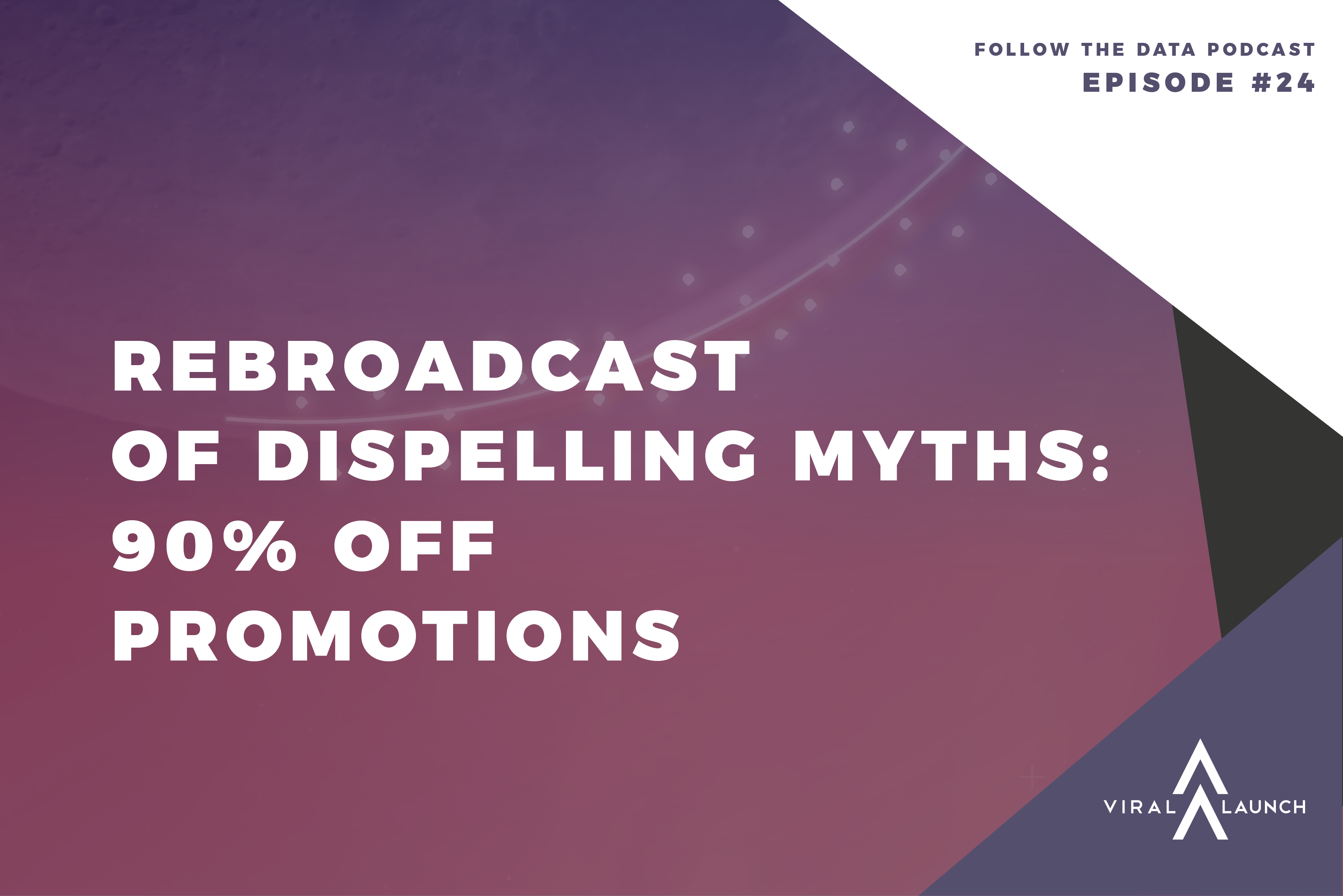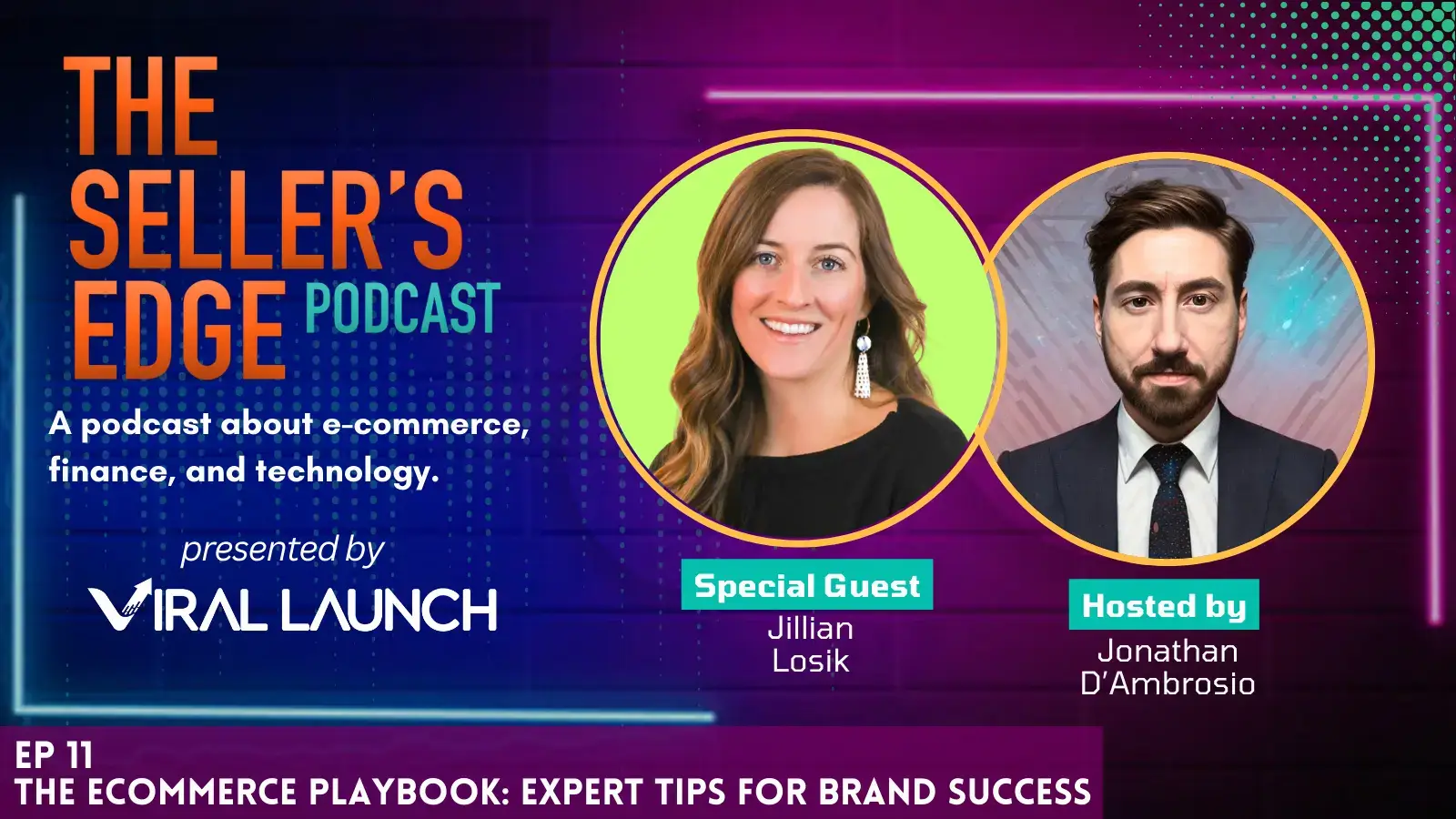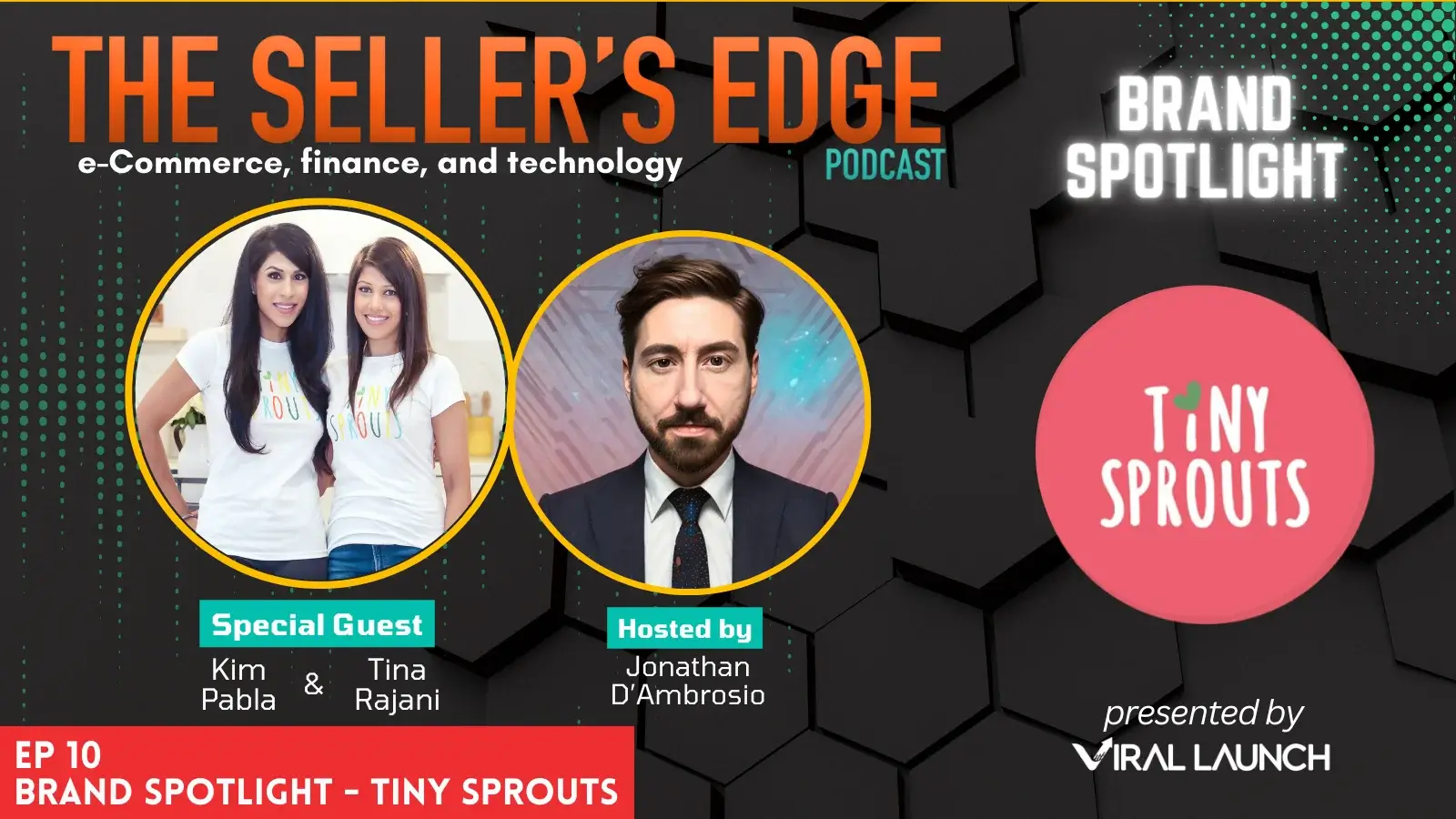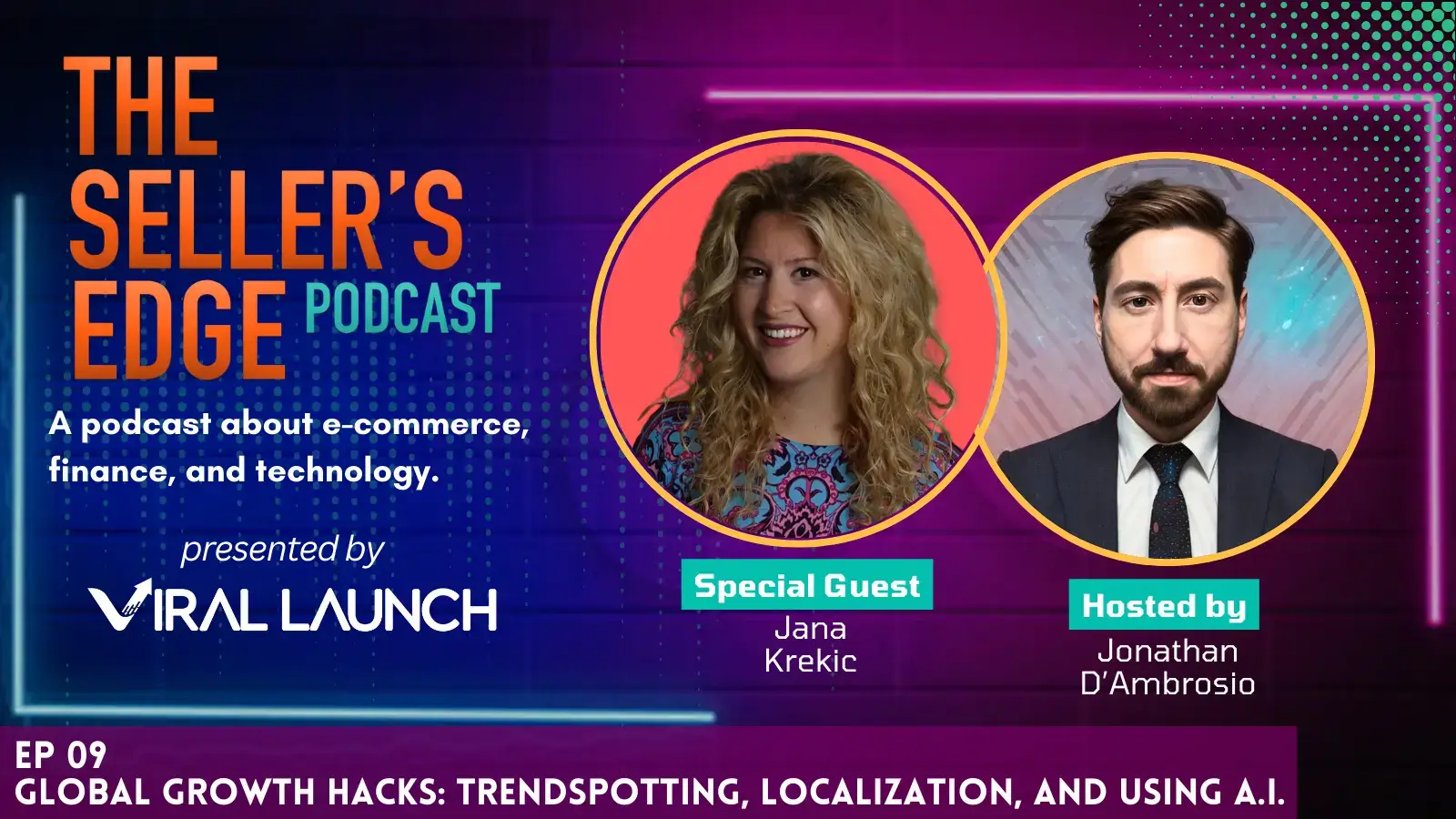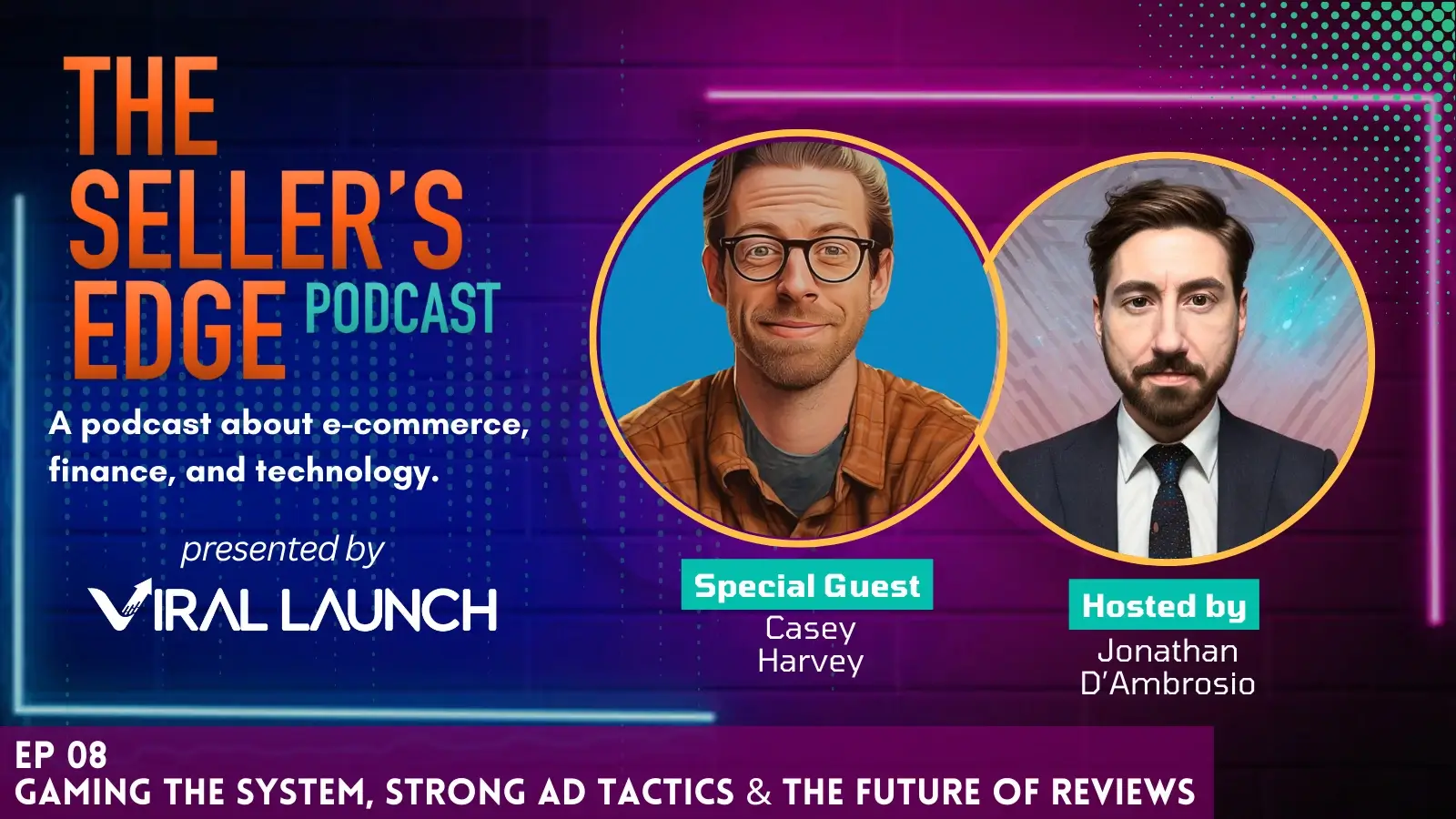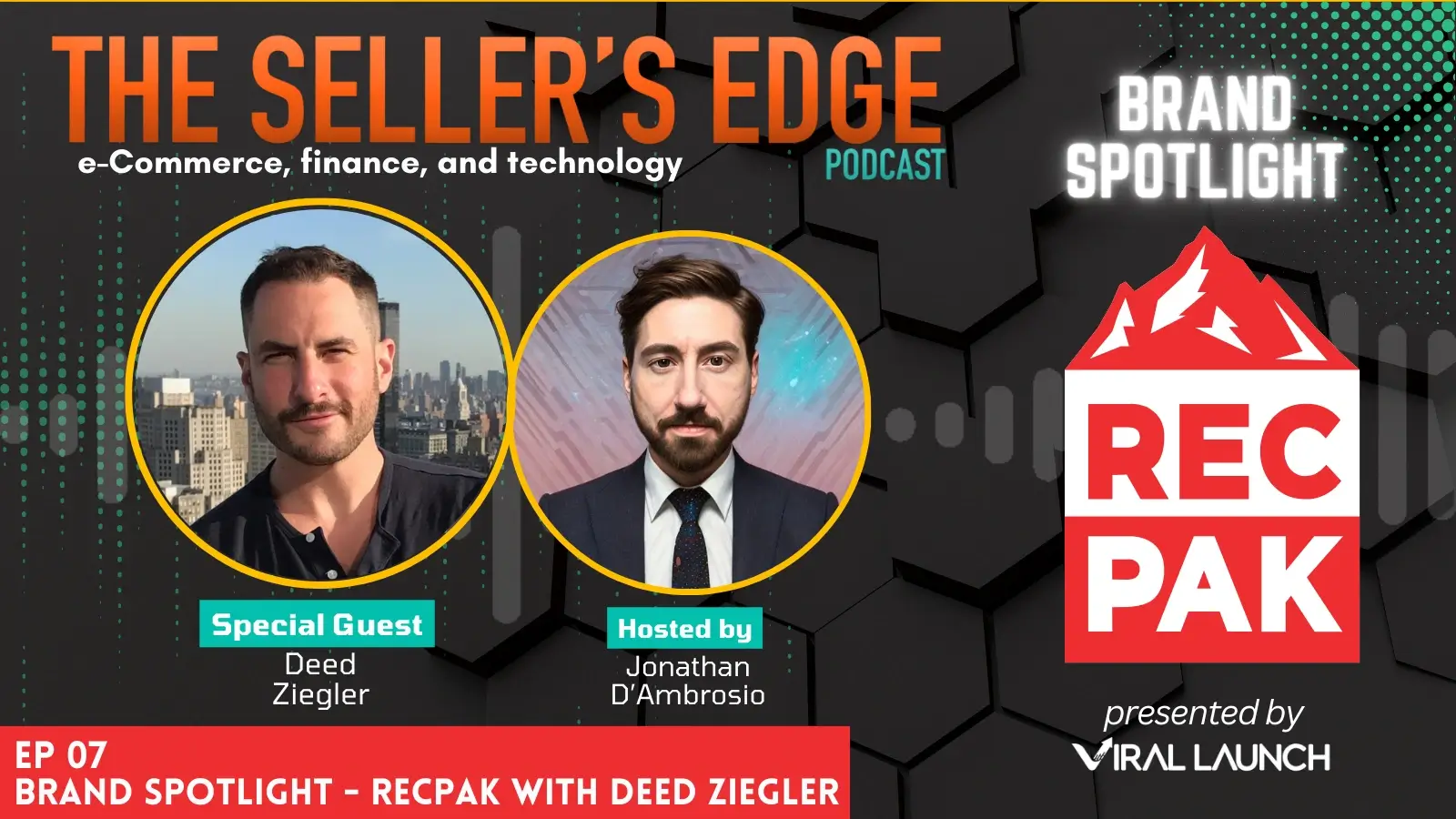Rebroadcast of Dispelling Myths: 90% Off Promotions (Follow the Data Ep. 24)
We’re off this week preparing for the launch of our latest software tool. If you want an exclusive offer and to be among the first to find out what the tool is, join us for the unveiling Tuesday March 6 at 8pm. Reserve your spot at launchevent.viral-launch.com In the meantime here’s a rebroadcast of Dispelling Myths: 90% Off Promotions.
Do launches work? Amazon gives higher keyword ranking to products sold at full price, leaving deeply discounted promotional products in the dust… Or so the myth goes. In the inaugural episode of the “Dispelling Myths” series, Viral Launch CEO Casey Gauss dives into the data to validate, or dispel, this widespread concern among Amazon sellers. Originally aired on October 5, 2017
Listen on iTunes Listen on Stitcher
Follow the Data Show Notes
- Be one of the first to see our newest software tool! Sign up to reserve your spot at the launch event webinar.
- Read our recent blog post about Viral Launches and how 90% off promotions continue to work for our customers.
- Looking to set up a Viral Launch? We’ve got a handy step-by-step walkthrough on our YouTube channel.
- Check out the Viral Launch YouTube channel and look for Cameron’s Product Discovery Strategy Guides where he walks through how to get the most out of Product Discovery.
Podcast Transcript
Casey Gauss:
Everyone’s looking for like that next hack. It makes logical sense that 90% off promotions don’t drive as much keyword ranking. You know the problem is that the data just doesn’t show that.
Cameron Yoder:
The buzz about town is that running promotions to get ranking may not work the way it used to. Today we’re diving into the data to see what’s really going on. I’m Cameron Yoder.
Casey Gauss:
And I’m Casey Gauss, your host for Follow the Data: Your Journey to Amazon FBA Success. So in this show we leverage the data we’ve accumulated at Viral Launch from over 20,000 product launches and our experience working with over 5500 brands on Amazon to help you understand the big picture when it comes to Amazon and, most importantly, the best practices for success as an Amazon seller.
Cameron Yoder:
These first four inaugural episodes of Follow the Data are all part of our Dispelling Myths series in which we explore topics that have garnered a lot of conversation among the Amazon seller community recently, but that until now have not been proven or disproven using factual evidence.
Casey Gauss:
We’ll talk about where these Amazon myths come from, why they seem to logically make sense, and what the data is saying, and what is actually happening and how you can apply that moving forward.
Cameron Yoder:
All right, Casey, so this is Episode 1 of Dispelling Myths. We’re talking about promotions here. Can you tell us a little bit about this myth? What exactly is this myth?
Casey Gauss:
Yeah, so essentially this myth is basically stating that Amazon gives higher ranking power or effect to sales at full price versus, you know, the promotions at 90% off. The theory is that if you are running a promotion, if you’re giving a product away at a discount or selling it at a discount, especially 90% off, you’re not going to get nearly as much ranking power as a full-price sale.
Cameron Yoder:
So someone selling on Amazon, let’s say they give away items at 50% off. People are saying that those are not as effective or efficient as – or that the 90% off promotions are not as effective or efficient as the 50% off coupons. Is that right?
Casey Gauss:
Yep, correct.
Cameron Yoder:
Okay, okay. So where – or when, when did this idea start? Like where did it come from?
Casey Gauss:
Yeah, you know, we’ve seen this idea ever since 2014 when we got started. To be honest, I think that it’s definitely had a resurgence. We’ve seen people say you know back in the day oh Amazon will only let a review stick, or you can only get review power if it is at zero dollars, or if it’s over five dollars. You know there’s always these kind of arbitrary metrics that people throw out, and so now there’s just this resurgence. You know I’ve probably seen it a lot more over the last three months maybe, maybe around May, maybe around June, somewhere around there.
Cameron Yoder:
So why do you think it’s researching? Like why is this coming back?
Casey Gauss:
The – so yeah, so I mean with any myth I think a lot of it boils down or finds its root in everyone’s looking for like that next hack. It makes logical sense that 90% off promotions don’t drive as much keyword ranking. You know the problem is that the data just doesn’t show that.
Cameron Yoder:
Another point I guess that’s important, right, is that I mean it would be really, really great if it wasn’t true, right, that oh, that means if 90% off promotions aren’t as effective or efficient, then we don’t have to give products away at 90% off. Like that is a very appealing notion, right? So then that means that sellers don’t have to give products away for extreme discounts.
Casey Gauss:
Yeah, okay, yeah, very true. I would definitely like to point that out as – so it’s called consistency bias, right?
Cameron Yoder:
Yeah, right.
Casey Gauss:
And so you don’t want to spend the money associated with selling product at 90% off, and so you would like to tell yourself that it is great to – or that Amazon prefers full-price sales, and that’s why you want to head that way. Oh yeah, so another instance in which this kind of comes up is, you know, people run one promotion and they don’t get the keyword ranking they expected to see, right? So I’m selling a fish oil. I think I need to give away 50 units a day, let’s just say. And so I do that, and I expected to get to page 1, but I only got to bottom of page 2, right? And so then instantly everybody would jump to oh my gosh, promotions don’t work nearly as well. It must be full-price sales that are the answer. And you know the problem with that is here’s where, you know, the Viral Launch data or perspective really comes into play is that we’re running hundreds and hundreds and hundreds of promotions every day. So we have tons of data where you know, we’re tracking keyword ranking –
Cameron Yoder:
Right.
Casey Gauss:
– for keywords, the targeted keyword, as well as keywords that we find in the title, in the bullet points, in the rest of the listings. So we really, really understand how sales interact with the content of a listing, or tracking the price point of sale, or tracking are coupons present when we have MWS access. And so yeah, we’re able to really get this really broad perspective of the market versus you run one promotion, maybe your keyword, main keyword, wasn’t in the title. Maybe it wasn’t in your listing at all. Maybe, you know, you weren’t even indexed for it, or you know there’s a number of different factors that – and sometimes you know there’s things like cursed products where we just cannot get those things to rank in –
Cameron Yoder:
Cursed products.
Casey Gauss:
Yeah, that’s what we call it. So yeah, there’s so many different variables coming into play that running one test and then not getting the results that you had expected or intended is not enough of a sample size to really draw a strong correlation or a strong conclusion.
Cameron Yoder:
Right. And we, in terms of data – like you were talking about data – we really have that sample size. Again, like we run – we run promotions every single day, and they’re all built off of – or not every single one, but almost all of them are built off of 90% off promotions.
Casey Gauss:
Yeah.
Cameron Yoder:
If that didn’t work and it wasn’t effective, it wouldn’t work for us.
Casey Gauss:
Right.
Cameron Yoder:
And we see it every single day.
Casey Gauss:
Yeah, so I mean getting into the data of it, simply we’re running hundreds and hundreds of launches, and the amount— our ability to drive keyword ranking is just insane. And so at the end of the day Amazon is paying attention to did a sale happen? They’re not paying attention to the number of units that occurred or the price at which it is actually purchased. I think Amazon cares or is paying more attention to the price that the product is listed at.
Cameron Yoder: Let’s transition to a break. We’ll be back right after this message.
Rebecca Longenecker:
Hey, I’m Rebecca Longenecker, the producer for Follow the Data, and I wanted to let you know about a really cool resource the Viral Launch team just published. With this holiday season promising to be the biggest yet for Amazon, we’re offering an e-book that walks you through every aspect of Q4 preparation, from inventory planning, to optimizing your listing for mobile, to making sure your product is showing up in search. We’ve got you covered. There are also fun facts, helpful notes and handy little checklists you can use to evaluate how prepared you are. Don’t miss out on this year’s holiday sales. Go to viral-launch.com/Q4 to download the e-book now. That’s viral-launch.com/Q4. Thanks!
Cameron Yoder:
And we’re back again talking about the myth of giveaways and promotions. So Casey, let’s talk a little bit more about the data that’s backing this dispelling up. Can you touch on everything just a little bit more?
Casey Gauss:
Yeah, you know I think the really simple analogy or the simple logic here to kind of give everyone an example is as simple as this. So let’s take fish oil as an example, and someone wants to run a promotion to get ranking for the keyword, “fish oil.” Well, what we do is we go and we look, okay, here’s page 1 for fish oil. You know these guys are selling, let’s say it’s 50 units a day average page 1 or bottom half of page 1. And we want to get ranking there. So what we will do is we will give away 50 units per day targeting this keyword, “fish oil,” and after three days, five days, maybe seven days we’ll be ranking bottom of page 1 for fish oil, and we did – we ran 90% off promotion. So 90% of the sale price, these guys are selling 50 units a day at the organic price, and we sold at 90% off, and we’re still able to drive the same amount of keyword ranking. And so again, if Amazon did not – or reduced the amount of keyword ranking power as some kind of function of the purchase price we would not be ranking alongside these people that are selling just as many units except at the organic price. So that alone kind of just busts that myth, completely dispels that.
You know, another area this myth came from is there are these, you know, quote unquote experts or service providers in the space that are saying oh, you have to do these full-price deals with us, and the reason they’re doing that and they’re promising these crazy affects, right? So if you come and use our service we will guarantee you hit page 1 or number one most of the time, and we guarantee you will stay there for 30 days. The reason our method is so effective is because we’re using these gift cards to run full-price sales, and in reality what people didn’t realize was this person was running a bot or this artificial ranking method to your listing, and that’s what was getting you the results. That’s what was helping to maintain those results. It wasn’t the fact that you used these gift cards. And so that’s really frustrating to me because one, you know this person is operating on your business without your consent in a black hat manner, and two, they’re just, you know, completely lying about what is driving the results, which then goes and leads people down these dark paths. You know, it is against terms of service to compensate someone or reimburse someone for buying your product. It is absolutely stated explicitly in the terms of service that you cannot do this. It’s black hat. You know, will you get caught for it? I personally don’t know anybody that has. But you know, I think it’s one little slip up and now you’re in trouble for, you know, manipulating Amazon’s system or compensating buyers for purchasing your product.
Cameron Yoder:
Right. Let’s touch a little bit on just like the mentality of why, like why 90%? So why not? Why not? Why can’t – people are asking, why can’t I just launch my product at 50% off? It’s still a heavy discount, right, so why is 90% necessary? Touch on that.
Casey Gauss:
Yeah, so the discounted price or percentage is not a function of effectiveness.
Cameron Yoder:
Right.
Casey Gauss:
It is really, you know, we’re running generally around 450 or so launches a day right now, and so yes, we have a buyer list of 350,000 in the US, but you know these guys have – some of these people have been on our list for, you know, years and years and years.
Cameron Yoder:
A long time.
Casey Gauss:
And so if we’re selling an iPhone 7 case or a fish oil, like this demographic that we have only has so much discretionary income, and if you’re selling your product at 50% off, let’s say $10, versus the usual $1, $2, whatever, like that’s $8 less discretionary income they have to go buy our other products. And so in order to make sure the demand is high enough in the group for every launch that we’re running, we want to keep prices as low as possible so they have the money to buy more stuff.
Cameron Yoder:
Right. The 90% off is very much – it’s a means of control. Like you need to move – you need to move, if you’re launching, again, for fish oil, you’re going to have to move an insane amount of units to get to the top. The 90% off really gives control and gives you the ability to launch to page 1 for that. So the 90% off is a means of moving the launch forward and making it effective.
Casey Gauss:
And you know, to be honest, from like a competitive standpoint, you know if I were a larger seller I would actually kind of prefer this because the smaller sellers don’t have the budget –
Cameron Yoder:
Right, right.
Casey Gauss:
– to be really aggressive in these high-volume markets at these low prices. So they have to, you know, work their way up in a much slower process. And as a larger seller, yes, it is more expensive, but you’re essentially pricing or paying your competitors out of the market, which, you know, for large sellers that works. For smaller sellers, you know, this is why we definitely suggest getting into smaller niches where you don’t have to give away 100 units a day for seven days just to get on page 1, let alone maintain that ranking or whatever.
Cameron Yoder:
Oh, but what about fidget spinners?
Casey Gauss:
Yeah. We don’t want to talk about those.
Cameron Yoder:
No, no, no. So that’s actually a good transition into the takeaway. Let’s talk about what is the main takeaway? From my perspective it’s all about the risk, right, the reward of the risk. You have to take a huge risk. You are taking an investment, kind of an investment with giving away this many units. But giving away this many units at a 90% off discount is going to give you the control and get you on to page 1. And from there, then you will be able to make that increase in sales.
Casey Gauss:
Yeah, oh, completely. I would say, especially like – or specifically to this particular myth I think the takeaways are one, really be careful of who you’re trusting and paying attention to. Two, definitely make sure that you are getting a really solid sample size when you are making conclusions. Again, running one promotion that doesn’t get the ranking effects that you expected it to, you know, maybe you underestimated the number of units needed to give because the guys on page 1 are selling more units through that keyword than you had anticipated. Who knows? But anyways, yeah, please pay attention to your sample size when drawing conclusions because the last thing you want is to draw some conclusion and then spend the next three months and $20,000 trying to build a business around this, you know, this wrongly-founded conclusion. Yeah, and then three, really is at the end of the day, like you have to spend money to make money, like Cam is saying.
Cameron Yoder:
Right, right.
Casey Gauss:
And you know, unfortunately that’s the case right now. And yeah, you know, we’re definitely biased in saying that, but the problem is in that bias like we’ve just seen so many people have success. We just posted three Viral Launch case studies where this guy came, and he was doing $400K a month, and he came in, ran promotions across his product line, and after 30 days he’s doing $650K a month organically just because he improved the keyword rank position of his product. So yeah, he spent a bunch of money. I thought it was $250,000 to get that ranking, but now, you know, his sales are just killing it compared to where he was at. So –
Cameron Yoder:
Yeah.
Casey Gauss:
Yeah.
Cameron Yoder:
Take a zoomed out perspective. Ask why with everything that you’re doing. Make sure you’re getting all the data. Make sure you’re getting all the facts.
Casey Gauss:
Awesome. All right. We’ll see you guys later.
Cameron Yoder:
Hey, that is all for this week. Thank you so much for joining us here on Follow the Data. For more reliable information about what’s really happening on Amazon subscribe to the podcast and check out the Viral Launch blog at Viral-Launch.com.
Casey Gauss:
And don’t forget to leave a review on iTunes if you liked or enjoyed the podcast. We really appreciate your feedback as we work to build this podcast for you. Want to be featured on the show? Leave us a voicemail and tell us your thoughts on today’s episode, or ask us any of your Amazon questions. Our number is 317-721-6590. It will be linked in the show notes. Join us next week when we dispel the myth of Amazon sales velocity. Until then, remember, the data is out there.
